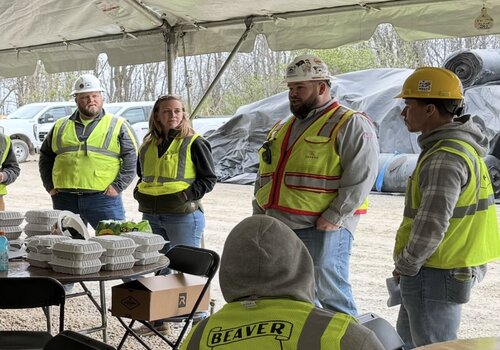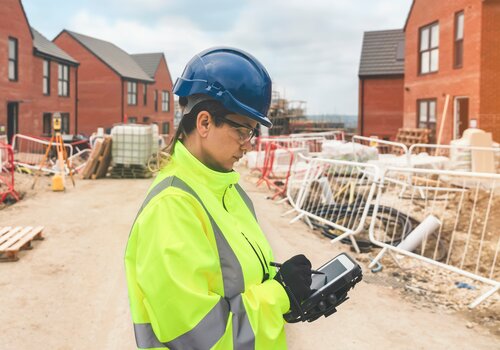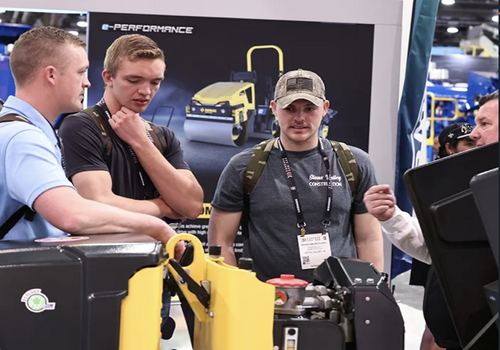April serves as a pivotal month for the construction industry to emphasize safety on roadways, marking both National Distracted Driving Awareness Month and National Work Zone Awareness Week (NWZAW). These initiatives aim to protect workers and drivers in work zones, fostering a safer environment for everyone.
NATIONAL DISTRACTED DRIVING AWARENESS MONTH
Distracted driving has become a critical issue on U.S. roads. In 2022, 3,308 lives were lost due to distracted driving incidents. And more than 32,000 people died in crashes involving distracted drivers from 2013-2022. Recognizing the severity of this problem, April has been designated by the U.S. Department of Transportation’s National Highway Traffic Safety Administration (NHTSA) as National Distracted Driving Awareness Month, a time to reflect on driving habits and commit to safer practices. At a time when everyone has a cell phone and
Understanding Distracted Driving
Distracted driving encompasses various activities that divert attention from driving, including:
- Visual distractions: Taking your eyes off the road.
- Manual distractions: Removing hands from the steering wheel.
- Cognitive distractions: Thinking about non-driving-related matters.
Texting is particularly hazardous as it involves all three types of distractions.
Safety Recommendations
To mitigate distracted driving:
- Pull Over: If you need to send a text, park safely before doing so.
- Designate a Texter: Assign a passenger to handle calls or messages.
- Stow Your Phone: Place your phone out of reach to avoid temptation.
These practices can significantly reduce the risk of accidents.
Enforcement Initiatives
From April 7 to 14, heightened law enforcement efforts will target distracted driving offenses. The “Put the Phone Away or Pay” campaign underscores the legal consequences of texting while driving, including fines.
NATIONAL WORK ZONE AWARENESS WEEK (NWZAW)
Coinciding with these efforts, NWZAW is observed from April 21 to 25, 2025, hosted by the North Carolina Department of Transportation. The theme, “Respect the zone so we all get home,” emphasizes the importance of caution in work zones.
Significance of NWZAW
Work zones present unique challenges and hazards. In 2022, 891 fatalities occurred in work zones, with 742 being drivers or passengers and 95 being highway workers. There was an estimated 96,000 total work zone crashes in 2022. These statistics highlight the need for increased awareness and safety measures.
Scheduled Events
- Work Zone Safety Training Day (April 21): Emphasizes training for safety.
- National Kickoff Event (April 22): Hosted by NCDOT.
- Go Orange Day (April 23): Encourages wearing orange to support work zone safety.
- Social Media Storm (April 24): Promotes sharing safety messages online.
- Moment of Silence (April 25): Honors those who lost their lives in work zones.
Role of the Construction Industry
The construction industry plays a vital role in these initiatives by:
- Implementing Safety Protocols: Ensuring workers are trained in safety measures.
- Collaborating with Authorities: Working with law enforcement to enhance work zone safety.
- Raising Public Awareness: Educating the public about the dangers of distracted driving and the importance of work zone safety.
April’s focus on distracted driving and work zone safety provides an opportunity for the construction industry to reinforce its commitment to protecting workers and the public. By actively participating in these initiatives, we can work towards a safer future on our roadways.
Year-Round Work Zone Safety Strategies for Construction Contractors
Work zone safety should be a priority every day, not just during National Work Zone Awareness Week. Construction contractors can take proactive steps to protect workers and drivers throughout the year. Here are some key strategies to enhance work zone safety on your jobsites.
1. Implement Comprehensive Safety Training
- Require all workers to complete regular safety training focused on work zone hazards, traffic control measures and emergency response.
- Use toolbox talks and safety courses to reinforce safe practices.
- Educate new hires about work zone protocols during onboarding.
2. Use Effective Traffic Control Measures
- Ensure work zones are clearly marked with proper signage, barriers and cones.
- Implement flagging operations with trained personnel when needed.
- Follow the Manual on Uniform Traffic Control Devices (MUTCD) for compliance with federal guidelines.
3. Utilize Technology for Enhanced Safety
- Deploy GPS-enabled wearable technology to track worker locations and alert them to approaching hazards.
- Use smart traffic signs that adjust based on real-time road conditions.
- Invest in innovative road technologies to reduce worker exposure to moving traffic.
4. Promote a “Heads Up” Culture
- Encourage workers to stay vigilant and avoid distractions like cell phones while on the job.
- Create a reporting system for near-miss incidents to improve awareness and prevention.
- Reinforce the importance of communication between equipment operators, ground workers, and flaggers.
5. Partner with Local Authorities
- Coordinate with local law enforcement and transportation agencies to implement safer traffic flow around worksites.
- Participate in community outreach programs to educate the public about work zone safety.
- Encourage police presence in high-risk work zones to deter speeding and reckless driving.
6. Conduct Routine Safety Audits
- Perform regular inspections to identify and mitigate risks in work zones.
- Adjust work zone setups as needed based on weather, traffic volume and project phases.
- Collect data on incidents and near misses to refine safety protocols.
Photo credit: P.LANGE/BIGSTOCKPHOTO.COM












